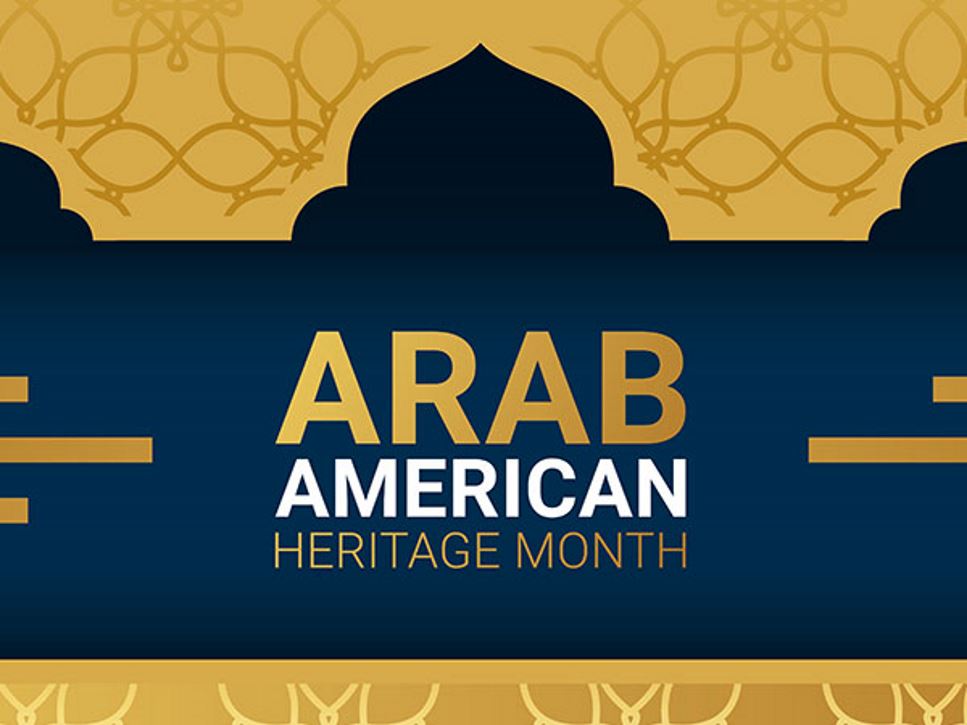April is National Arab American Heritage Month, a time to recognize Arab Americans’ culture, heritage, achievements and contributions to the United States. This initiative was launched in 2017 with support from only a small number of states. Since then, its observance has become permanent in four states, recognized by President Biden in 2021 and 2022, and proclamations for National Arab American Heritage Month have been issued by governors of 45 states and Congress.
According to the Arab American Institute, there are approximately 3.7 million Arab Americans living in the U.S. While some people may confuse the terms “Arab” and “Middle Eastern,” these words are not interchangeable. Arabs are connected by a shared culture and history, not race. Arab countries include those within as well as outside of the geographical Middle East region such as Egypt, Morocco and Tunisia. The Middle East encompasses some non-Arab countries as well, such as Iran, Israel and Turkey. Each Arab country has its own distinct culture, history and Arabic dialect.
There are 22 Arab countries across the Middle East and North Africa: Algeria, Bahrain, the Comoro Islands, Djibouti, Egypt, Iraq, Jordan, Kuwait, Libya, Morocco, Mauritania, Oman, Palestine, Qatar, Saudi Arabia, Somalia, Sudan, Syria, Tunisia, the United Arab Emirates, Lebanon and Yemen. Most Arabs in the U.S. are of Lebanese, Syrian, Palestinian, Egyptian or Iraqi descent.
While Arab Americans can be found living across the entire United States, two-thirds reside in just 10 states: California, Florida, Illinois, Michigan, New Jersey, New York, Ohio, Pennsylvania, Texas and Virginia. The largest percentage of Arab Americans live in Dearborn, Michigan.
An integral part of American history, Arab Americans hold positions across all sectors including business, military, political and medical fields. This month and throughout the year, celebrate Arab Americans by learning more about their contributions, food and culture.
Culture and Religion
Many customs and food traditions are influenced by religion. Most people in the Arab world are Muslim, or people who follow Islam. However, in the U.S., around 65-70% of Arab Americans are Christian, namely Roman Catholic. Approximately 30-35% of Arab Americans in the U.S. are Muslim. However, recent years have seen an influx of Muslim Arabs immigrating to the United States, so these statistics may not be as representative of current numbers.
Christian Arabs have shared origins with Christianity, but there are some subtle differences depending on the specific church of Christianity, such as Coptic or Maronite.
Muslim Arabs observe two main holidays: Eid Al Fitr, a celebration to mark the end of fasting for the month of Ramadan, and Eid Al Adha, a commemoration to the pilgrimage to Makkah. Muslims eat foods that are halal, which means permissible to eat in Islam. However, the extent to which these guidelines are followed can vary based on cultural and family traditions. Meat that is halal means it is prepared according to Islamic law. Muslims abstain from all pork and its byproducts, as well as alcohol.
Food
Arabs are known for their generosity and hospitality, especially when it comes to food. Falafel, shawarma, hummus, baba ghanoush, fattoush and tabbouleh are just a few common foods in Arab cuisine. Variations of these dishes depend on the Arab region and traditional recipes passed down through generations.
Arab food staples include olives, labneh (strained yogurt dip), olive oil, za'atar, halloumi cheese, jam preserves, halaweh (also known as halva, a sweet snack), fava beans, chickpeas, bread, dried dates, pine nuts and almonds, to name a few. Condiments include tahini, pomegranate molasses and date syrup. Spices and herbs are an important part of traditional Arab dishes and include sumac, cumin, oregano, seven-spice seasoning mix, parsley, mint and coriander.
Depending on the country of origin, popular dishes may include stuffed grape leaves, mahshee (stuffed zucchini and eggplant), freekeh with lamb meat, kabseh or mansaf (rice with meat), kibbeh (fried stuffed bulgur and meat ball), grilled kabob and lamb tagine. Desserts include knaffe (shredded phyllo dough with cheese), awwameh (fried dough balls) and baklava (layers of phyllo dough with walnuts) drizzled with a sugary syrup. No meal is complete without Arabic coffee, also known as Turkish coffee, or tea.
Arab Americans are an invaluable part of the mosaic of cultures in the United States. There is no better time to learn about and celebrate Arab Americans than National Arab American Heritage Month.
Resources
Learn more about Arab Americans with these additional resources:
- Academy of Nutrition and Dietetics’ Religion Member Interest Group
- Academy of Nutrition and Dietetics Michigan Affiliate
- Arab American Institute
- Arab America Foundation
- Arab American National Museum
- National Endowment for the Humanities
- Center for Arab American Studies
- American-Arab Anti-Discrimination Committee (ADC)
- Learning for Justice
- Halal Research Council
Note: This list is not all-inclusive. The Academy of Nutrition and Dietetics has not participated in the development of the sites listed and does not exert any editorial or other control over the sites or content.
Find a Nutrition Expert
Looking for credible nutrition information and recommendations? The Academy of Nutrition and Dietetics' network of credentialed food and nutrition practitioners are ready to help!

